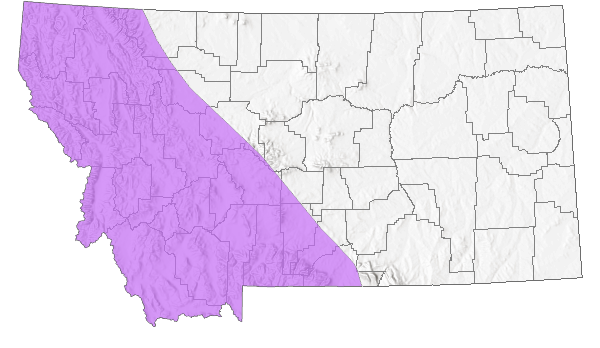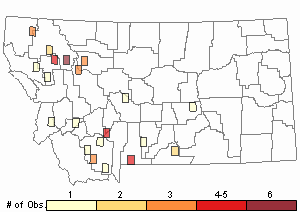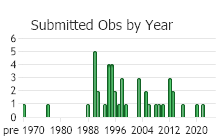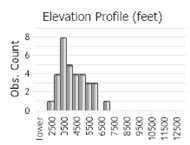View in other NatureServe Network Field Guides
NatureServe
Montana
Utah
Wyoming
Idaho
Wisconsin
British Columbia
South Carolina
Yukon
California
New York
Beaked Spikerush - Eleocharis rostellata
State Rank Reason (see State Rank above)
Known from over a dozen extant sites and a few historical locations. Private and state lands host many occurrences that are vital to the viability of the species in the state. The species is vulnerable to hydrologic alteration and development.
- Details on Status Ranking and Review
Population Size
Score1 - Moderate: Generally 10,000-100,000 individuals.
CommentPopulation estimates are imprecise though appear to be less than 100,000 stems.
Range Extent
Score0 - Widespread species within Montana (occurs in 5% or more of the state or generally occurring in 6 or more sub-basins.) as well as outside of Montana.
Area of Occupancy
Score1 - Moderate: Generally occurring in 11-25 Subwatersheds (6th Code HUC’s).
Environmental Specificity
Score2 - High: Species is restricted to a highly specialized and limited habitat and is typically dependent upon unaltered, high-quality habitat (C Values of 8-10).
Trends
Score1-2 - Minor to Moderate Declines:
CommentTrends are undocumented, though some declines from habitat loss/alteration seem likely, but it does not appear that the declines have been severe.
Threats
Score1 - Medium: 11-30% of the populations are being negatively impacted or are likely to be impacted by one or more activities or agents, which are expected to result in decreased populations and/or habitat quality and/or quantity.
CommentHabitat loss/alteration and hydrologic alterations.
Intrinsic Vulnerability
Score0-1 - Low to Moderate Vulnerability.
Raw Conservation Status Score
Score
6 to 8 total points scored out of a possible 19.
General Description
PLANTS: Cespitose, perennial herbs with erect or arching stems reaching 10 to 80 cm tall. Plants have short shallow rhizomes and may also root at the stem tip by means of an apical bulbil. Source: Lesica et al. 2012.
LEAVES: Leaves are bladeless and reduced to 2 sheaths on the lower stem. The sheath of the distal leaf is firm and persistent. Leaf tip obtuse to subacute without a tooth-like projection. Source: Lesica et al. 2012.
INFLORESCENCE: A 4 to 15 mm long single spikelet with few to many flowers. Florets are tightly packed and spirally arranged. Source: Lesica et al. 2012.
The specific epithet rostellata originates from the Latin adjective rostellatus meaning “equipped with a beak” or “beaklike” (Arsenijevic et al. 1995). Eleocharis is made up of the two Greek words hele- and -charis meaning “marsh” and “grace” respectively (Merriam-Webster).
Phenology
Beaked Spikerush flowers in July; mature fruits develop from July to August (Smith in Flora of North America (FNA) 2002).
Diagnostic Characteristics
Montana has eight
Eleocharis species. They are generally mat-forming wetland herbs with inflorescences consisting of a single, solitary spikelet (Lesica et al. 2012).
Beaked Spikerush -
Eleocharis rostellata, SOC
*Habit: A low-growing, tufted (cespitose) perennial. Stems are erect or arching and rooting at the tips.
*Stems: More or less flat, some arching to the ground and rooting at the tips. Plants are 10-80 cm tall.
*Spikelets: 4-10 mm long with few to many flowers.
*Achenes: Grayish-green, about 2 mm long. The upper portion of the achene is conical and confluent with the lower portion that is 3-sided to nearly round in cross section.
*Stigmas: 3
Creeping Spikerush -
Eleocharis palustris,
*Habit: An erect, rhizomatous perennial.
*Stems: More or less cylindrical stems that are 7-90 cm tall with purple bases.
*Spikelets: 5-25 mm long with numerous flowers.
*Achenes: A yellow to brown, smooth, obovate achene that is 2-3 mm long. The upper portion of the achene is pyramidal in shape and appearing separated from the lower portion which is orbicular to lenticular in shape.
*Stigmas: 2
Few-flower Spikerush -
Eleocharis quinqueflora,
*Habit: An erect, short-rhizomatous perennial.
*Stems: 5-25 cm tall and tufted.
*Spikelets: 4-8 mm long and usually with 5 flowers.
*Achenes: Brown, smooth, narrowly obovate, and 2-3 mm long. The upper portion of the achene forms a distinct beak that is confluent with the lower portion that is 3-sided.
*Stigmas: 3
Species Range
Montana Range
Range Descriptions

 Native
Native
Range Comments
Beaked Spikerush occurs from British Columbia to Nova Scotia south through most of the United States to Mexico (Lesica et al. 2012).
Observations in Montana Natural Heritage Program Database
Number of Observations: 47
(Click on the following maps and charts to see full sized version)
Map Help and Descriptions
Relative Density

Recency



 (Observations spanning multiple months or years are excluded from time charts)
(Observations spanning multiple months or years are excluded from time charts)
Habitat
Eleocharis rostellata prefers wet, often alkaline soils, associated with warm springs or fens in the valley and foothills zones of Montana (Lesica et al. 2012). It may also occur in various other types of alkaline wetlands including salt and brackish marshes, tidal flats, alkaline seeps, bogs, stream margins, hot spring edges, and swamps (Carey 1994).
National Vegetation Classification System Groups Associated with this Species
Wetland and Riparian
Alkaline - Saline Wetlands
Peatland
Wet Meadow and Marsh
Ecology
ASSOCIATED SPECIES
In Montana wetlands, Beaked Spikerush is commonly associated with Common Arrowgrass (Triglochin miritimum), Hardstem Bulrush (Scirpus acutus), Torrey’s Rush (Juncus torreyi), and Alkali Muhly (Muhlenbergia asperifolia) (Carey 1994). Adjacent communities may be dominated by sedges (Carex spp.), Shrubby Cinquefoil (Dasiphora fruiticosa), or Tufted Hairgrass (Deschampsia cespitosa) (Greenlee 1999).
FIRE
Although wetland habitats have a lower probability of high intensity burning in any given year, they may experience varying levels of fire in seasons when the water table recedes (Carey 1994). After low intensity fires, Beaked Spikerush is able to sprout from its rhizomes even if all above ground plant matter is burned. It is also considered an early successional species and may recolonized wetlands after high intensity burns in marshy areas. A stable fire regime is important for keeping less fire tolerant species from displacing Beaked Spikerush.
BEAVER INTERACTIONS
Beaver are often necessary for maintaining suitable habitat for Beaked Spikerush by creating flood disturbance and saturated wetland conditions (Glisson 2003). Damming and flooding slows encroachment by woody species which creates open areas where shade intolerant species like Beaked Spikerush can receive at least partial sun. Due to their essential role in sustaining stable wetland habitat, beaver create suitable habitat for Beaked Spikerush, affecting its population dynamics and distribution.
HERBIVORY
Stems, roots, and achenes of spikerush (Eleocharis spp.) are an important food source for waterfowl (Carey 1994). Eleocharis rostellata dominated communities provide a source of forage early in the spring and attract various wildlife (Greenlee 1999). However, when plants have matured later in the season, palatability is low for livestock and other wildlife (Carey 1994).
SUCCESSIONAL STATUS
Beaked Spikerush is a pioneer species that can colonize marl beds and accelerate peat accumulation (Carey 1994). Eventually, hummocks of Beaked Spikerush form which may succeed into moss mats or larger hummocks dominated by shrubs. Later succession stages evolve toward cedar-dominated communities when water-table levels drop.
The above- and below-ground biomass of Beaked Spikerush was studied at various swamps in New York (Seischab et al. 1985). Above-ground standing biomass was highest in wet, minerotrophic sites followed by old, well-established sites, and least in young marl-bed sites. The marl bed site exhibited an early successional state, and therefore, plants allocated most of their resources to sexual reproduction and not vegetative growth. Below-ground biomass of plants in the old, well-established site was three times higher than in the wet, minerotrophic site and five times that of the young, marl bed site. This was most likely because the older site had been occupied by Beaked Spikerush for a longer than the other sites which created a greater accumulation of biomass. While allocation to specific structures fluctuated, overall biomass was not significantly different between sites, indicating that Beaked Spikerush is adapted to living in highly variable conditions and degrees of succession.
Reproductive Characteristics
Beaked Spikerush has low seed abundance, slow seed spread rate, low seedling vigor, and moderate vegetative spread rate (USDA, NRCS 2019).
FLOWERS [Lesica et al. 2012]
Flowers consist of 6 perianth bristles, 3 stigmas, and 3 stamens. The perianth bristles are usually equal in length to the achene. The scales are 2-6 mm long, rounded, and brown to purple with broad, hyaline margins. The lowest scale is empty.
ACHENES [Lesica et al. 2012]
Achenes are grayish-green and about 2 mm long. The upper portion of the achene is conical and confluent with the lower portion that is 3-sided to nearly round in cross section.
VEGETATIVE [Carey 1994]
Beaked Spikerush has the ability to reproduce vegetatively by sprouting from short, shallow rhizomes. Vegetative regeneration may also occur through a process called layering in which the individual roots at the stem tip and sprouts from the apical bulbil.
LIFE CYCLE [Carey 1994]
Beaked Spikerush is a perennial species. Flowering occurs in late spring and is followed by seed production which begins in mid to late summer and continues into fall.
Management
An essential first step to preserving existing populations of Beaked Spikerush is to monitor human activity to determine if habitat is being negatively impacted (Glisson 2003). Conservation measures to protect vulnerable habitat should address hydrologic alterations which could result from land development and certain grazing practices (Glisson 2003). Prescribed, low-severity fires may maintain early successional conditions in which Eleocharis species thrive (Glisson 2003).
Stewardship Responsibility
Threats or Limiting Factors
Across its range many threats have been reported in the literature:
Major threats to Beaked Spikerush include habitat alteration and physical damage caused by livestock (Carey 1994). Populations that occur near hot springs and along stream margins are at higher risk of disturbance from recreation (Carey 1994). The narrow habitat at the edges of stream margins is vulnerable to damage by livestock trampling and soil compaction (Carey 1994). Soil compaction reduces moisture holding capacity which adversely affects Beaked Spikerush (Glisson 2003).
Noxious weeds and other invasive species also pose a serious threat to Beaked Spikerush populations (Glisson 2003). Aggressive non-natives such as Russian Olive (Elaeagnus angustifolia), Salt Cedar (Tamarix ramosissima), Canada Thistle (Cirsium arvense) and Purple Loosestrife (Lythrum salicaria) may out-compete Beaked Spikerush (Glisson 2003). Treating exotic plants with herbicides that then affect water quality is detrimental to Beaked Spikerush and other native wetland plants (Glisson 2003).
STATE THREAT SCORE REASON
Reported threats to Montana's populations of Beaked Spikerush are those that impact its habitat around hot springs (MTNHP Threat Assessment 2021). Noxious weeds and non-native grass species including Canada Thistle (Cirsium arvense), Ox-eye Daisy (Leucanthemum vulgare), and Redtop (Agrostis gigantea) are established in the vicinity of some populations. At least one population along a road is likely extirpated following a period of road construction and maintenance. Concerns that populations located on private land could be developed has been raised. The threat of altered hydrological conditions (i.e., shrinking wetlands) due to climate change is recognized as real at all locations; however short-term data or observations have not been brought forth. Information on the scope, severity, and/or timing of existing threats to Beaked Spikerush is needed.
References
- Literature Cited AboveLegend:
 View Online Publication
View Online Publication Lesica, P., M.T. Lavin, and P.F. Stickney. 2012. Manual of Montana Vascular Plants. Fort Worth, TX: BRIT Press. viii + 771 p.
Lesica, P., M.T. Lavin, and P.F. Stickney. 2012. Manual of Montana Vascular Plants. Fort Worth, TX: BRIT Press. viii + 771 p. MTNHP Threat Assessment. 2021. State Threat Score Assignment and Assessment of Reported Threats from 2006 to 2021 for State-listed Vascular Plants. Botany Program, Montana Natural Heritage Program, Helena, Montana.
MTNHP Threat Assessment. 2021. State Threat Score Assignment and Assessment of Reported Threats from 2006 to 2021 for State-listed Vascular Plants. Botany Program, Montana Natural Heritage Program, Helena, Montana.
- Additional ReferencesLegend:
 View Online Publication
View Online Publication
Do you know of a citation we're missing? Fertig, W. and G. Jones. 1992. Plant communities and rare plant species of the Swamp Lake Botanical Area, Clark's Fork Ranger District, Shoshone National Forest. Unpublished report to the Shoshone National Forest. Challenge Cost Share Agreement No. CSA-2-91-14-0001. Wyoming Natural Diversity Database. 113+ pp.
Fertig, W. and G. Jones. 1992. Plant communities and rare plant species of the Swamp Lake Botanical Area, Clark's Fork Ranger District, Shoshone National Forest. Unpublished report to the Shoshone National Forest. Challenge Cost Share Agreement No. CSA-2-91-14-0001. Wyoming Natural Diversity Database. 113+ pp. Heidel, B. 1994. Potential impact of proposed noxious weed treatment at Bluewater Fish Hatchery (MDFWP) on plant species of special concern. Unpublished report to Gary Shaver, Bluewater Fish Hatchery. Montana Natural Heritage Program, Helena, Montana. 5 pp.
Heidel, B. 1994. Potential impact of proposed noxious weed treatment at Bluewater Fish Hatchery (MDFWP) on plant species of special concern. Unpublished report to Gary Shaver, Bluewater Fish Hatchery. Montana Natural Heritage Program, Helena, Montana. 5 pp. Jones, W. W. 1901. Preliminary flora of Gallatin County. M.S. Thesis. Bozeman, MT: Montana State College. 78 pp.
Jones, W. W. 1901. Preliminary flora of Gallatin County. M.S. Thesis. Bozeman, MT: Montana State College. 78 pp. Lesica, P. 1990. Vegetation and sensitive plant species of wetlands associated with geothermal areas in the greater Yellowstone ecosystem in Montana. Unpublished report on file at the Montana Field Office, The Nature Conservancy, Helena. 9 pp.
Lesica, P. 1990. Vegetation and sensitive plant species of wetlands associated with geothermal areas in the greater Yellowstone ecosystem in Montana. Unpublished report on file at the Montana Field Office, The Nature Conservancy, Helena. 9 pp. Lesica, P. 1991. The Rare Vascular Plants of Pine Butte Swamp Preserve. Unpublished Report to the Nature Conservancy. 15 Pp.
Lesica, P. 1991. The Rare Vascular Plants of Pine Butte Swamp Preserve. Unpublished Report to the Nature Conservancy. 15 Pp. Lesica, P., M.T. Lavin, and P.F. Stickney. 2022. Manual of Montana Vascular Plants, Second Edition. Fort Worth, TX: BRIT Press. viii + 779 p.
Lesica, P., M.T. Lavin, and P.F. Stickney. 2022. Manual of Montana Vascular Plants, Second Edition. Fort Worth, TX: BRIT Press. viii + 779 p. Vanderhorst, J.P. and B.L. Heidel. 1995. Sensitive plant survey in the Tobacco Root Mountains, Madison County, Montana. Unpublished report to the Beaverhead and Deerlodge National Forests. Montana Natural Heritage Program. Helena, MT. 66 pp. plus appendices.
Vanderhorst, J.P. and B.L. Heidel. 1995. Sensitive plant survey in the Tobacco Root Mountains, Madison County, Montana. Unpublished report to the Beaverhead and Deerlodge National Forests. Montana Natural Heritage Program. Helena, MT. 66 pp. plus appendices.
- Web Search Engines for Articles on "Beaked Spikerush"





